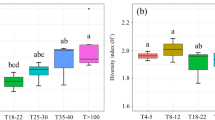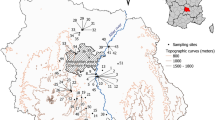Abstract
Transects across undisturbed marine sand dunes sequentially traversed the following plant communities: littoral, foredunes, intradune complex of ridges and hollows, deflation plain, myrtle forest, and mature conifer forest. Organic carbon levels were low in the littoral zone and increased across the dune ecosystem landward to the forest communities. The highest percentage of nutrients was isolated from the heavy fraction of soil residues. Soil microfloral populations responded to vegetation, physical dune characteristics, and seasonal moisture patterns. Populations of bacteria and actinomycetes were higher in winter than during summer sampling periods in all communities. Populations of microscopic fungi were higher in winter in all the communities except the hollows. The distribution of vesicular-arbuscular mycorrhizal fungi responded to vegetation and sand dune succession but did not display seasonality. Species of Gigaspora and Acaulospora were the most commonly isolated VAM fungi.
Sand aggregation increased along the dune transect and was correlated to plant community succession: the most highly aggregated soil was found in the two forest communities. With scanning electron microscopy, sand grains and organic residues were observed entangled by strands of filamentous mciroorganisms. Many of the filaments were of the dimensions of VAM fungi, which may be important for the release of nutrients associated with the cementing agents of sand aggregates and for the survival of early pioneer plants of sand dunes.
Similar content being viewed by others
References
Alexander M 1977 Soil Microbiology. John Wiley and Sons. New York, 467 p.
Barratt B C 1962 Soil organic regime of coastal sand dunes. Nature 196, 835–837.
Bond R D and Harris J R 1964 The influence of the microflora on physical properties of soils I. Effect associated with filamentous algae and fungi. Aust. J. Soil Res. 2, 111–122.
Clough K S and Sutton J C 1978 Direct observation of fungal aggregates in sand dune soil. Can. J. Microb. 24, 333–335.
Cooper W S 1967 Coastal dunes of California. The Geological Society of America Memoir 104, Boulder, Colorado.
Dunn P H and Baker G E 1983 Filamentous fungi of the psamon habitat of Enewetak Atoll, Marshall Islands. Mycologia 75, 839–853.
Ernest W H, Duin W E Van and Oolbekking G T 1984 Vesiculararbuscular mycorrhiza in dune vegetation. Acta Bot. Neerl. 33, 151–160.
Forster S M and Nicolson T H 1981a Aggregation of sand from a maritime embryo sand dune by microorganisms and higher plants. Soil Biol. Biochem. 13, 199–203.
Forster S M and Nicolson T H 1981b Microbial aggregation of sand in a maritime dune succession. Soil Biol. Biochem. 13, 205–208.
Gerdemann J W and Nicolson T H 1963 Spores of mycorrhizalEndogone species extracted from soil by wet sieving and decanting. Trans. Br. Mycol. Soc. 46, 235–244.
Gerdemann J W and Trappe J M 1974 The endogonacease in the Pacific Northwest. Mycologia Memoir No. 5. The New York Botanical Garden, New York. 76 p.
Giovanetti M and Nicolson T H 1983 Vesicular-arbuscular mycorrhizas in Italian sand dunes. Trans. Brit. Mycol. Soc. 80, 552–556.
Hutchins A S 1980In vitro inhibition of root-rot pathogensPhellinus weirii, Armellariella mellea, Fomes annosus, andPhytophthora cinnamomi by a newly isolatedBacillus sp. Microb. Ecology 6, 253–259.
Koske R E 1981 A preliminary study of interactions between species of vesicular-arbuscular fungi in a sand dune. Trans. Brit. Mycol Soc. 76, 411–416.
Koske R E, Sutton J C and Sheppard B R 1975 Ecology of Endogone in Lake Huron sand dunes. Can. J. Bot. 53, 87–93.
Koske R E and Halvorson W L 1981 Ecological studies of vesicular-arbuscular mycorrhizae in a barrier sand dune. Can. J. Bot. 59, 1413–1422.
Koske R E and Polson W R 1984 Are VA mycorrhizae required for sand dune stabilization? BioScience 34, 420–424.
Nemec S, Menge J A, Patt R G and Johnson L V 1981 Vesicular-arbusculr mycorrhizal fungi associated with citrus in Florida and California and notes on their distribution and ecology. Mycologia 73, 112–127.
Nicolson T H 1960 Mycorrhiza in the Gramineae. II. Development in different habitats, particularly sand dunes. Trans. Brit. Mycol. Soc. 43, 132–145.
Nicolson T H and Johnston C 1979 Mycorrhiza in the Gramineae III.Glomus fasciculatus as the endophyte of pioneer grasses in a martime sand dune. Trans Brit. Mycol. Soc. 72, 261–68.
Philips J M and Hayman D S 1970. Improved procedures for clearing roots and staining parasitic and vesicular-arbuscular mycorrhizae fungi for rapid assessment of infection. Trans. Br. Mycol. Soc. 55, 158–161.
Salisbury E J 1922 The soils of Blakeney Point: a study of soil reaction and succession in relation to plant covering. Ann. Botany 36, 391–431.
Spycher G, Sollins P and Rose S L 1983 Carbon and nitrogen in the light fraction of a forest soil: vertical distribution and seasonal patterns. Soil Science 135, 79–87.
Steel R G D and Torrie J H 1960 Principles and Procedures of Statistics. McGraw-Hill Book Co. New York 481 p.
Sutton J C and Sheppard B R 1976 Aggregation of sand-dune soil by endomycorrhizal fungi. Can. J. Bot. 54, 326–333.
Tisdal J M and Oades J M 1982 Organic matter and waterstable aggregates in soils. J. Soil Sci. 33, 141–163.
Walker J, Thompson C H, Fergus I F and Tunstall B R 1981 Plant succession and soil development in coastal sand dunes of subtropical eastern Australia. pp. 107–131.In Forest Succession: Concepts and Application. Ed. D C West et al. Springer Verlag, NY, NY.
Watson E T and Williams S T 1974 Studies on the ecology of actinomycetes in soil. VII. Actinomycetes in a coastal sand belt. Soil Biol. Biochem. 6, 43–52.
Webley D M and Eastwood D J 1952 Development of a soil microflora in relation to plant succession on sand-dunes, including the ‘rhizosphere’ flora associated with colonizing species. J. Ecol. 40, 168–178.
Author information
Authors and Affiliations
Rights and permissions
About this article
Cite this article
Rose, S.L. Above and belowground community development in a marine sand dune ecosystem. Plant Soil 109, 215–226 (1988). https://doi.org/10.1007/BF02202087
Received:
Revised:
Issue Date:
DOI: https://doi.org/10.1007/BF02202087




